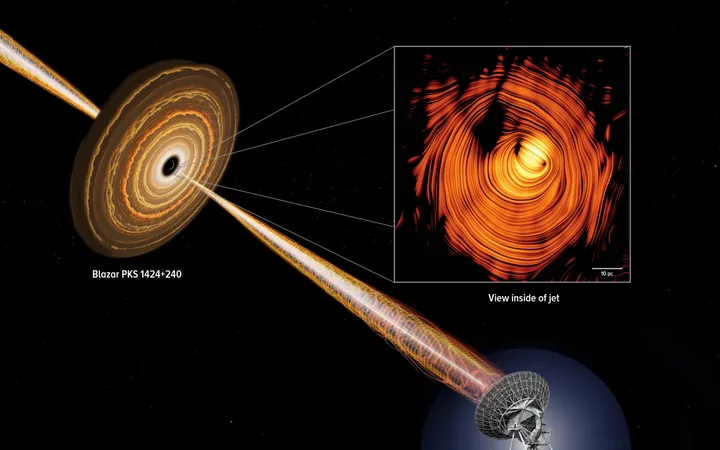
Astronomers Unlock Secrets of the "Eye of Sauron" with Groundbreaking Cosmic Research
2025-08-12
Author: Wei Ling
A Cosmic Riddle Unraveled!
In an exciting breakthrough, a team of international astronomers using the National Science Foundation's Very Long Baseline Array (VLBA) has finally shed light on a mysterious cosmic phenomenon. For over a decade, scientists have grappled with the enigma of a blazar known as PKS 1424+240, affectionately dubbed the "Eye of Sauron" for its eye-catching appearance. New findings, released in Astronomy & Astrophysics Letters, reveal this blazar’s jet is aimed almost directly at Earth, creating an astonishing cosmic lighthouse effect!
The Puzzle of Contradictory Signals
Situated billions of light-years away, PKS 1424+240 was long a source of confusion. It appeared to eject slowly moving plasma in radio observations but shone as one of the brightest sources of high-energy gamma rays and cosmic neutrinos in the universe. This contradiction, referred to as the "Doppler factor crisis," posed significant challenges to our understanding of cosmic accelerators.
Cutting-Edge Technology Reveals Incredible Insights
Thanks to 15 years of high-resolution data from the VLBA, a network of ten radio telescopes stretching from Hawaii to the U.S. Virgin Islands, the researchers were able to peer into the heart of this cosmic giant. Lead author Yuri Kovalev commented, "We discovered that the blazar's jet is aimed at us with pinpoint precision—only 0.6 degrees off our line of sight!" This remarkable accuracy has enabled astronomers to gain insights previously thought impossible.
A Closer Look: What They Found
The findings are as mesmerizing as they are significant. Co-author Jack Livingston referred to their observations as akin to viewing car headlights from the Moon, thanks to the VLBA’s unrivaled precision. They uncovered a near-perfect toroidal magnetic field entwined with the jet of plasma. Co-author Alexander Plavin added, "It resembles the Eye of Sauron from Tolkien's epic saga!"
Illuminating the Night Sky
The precise alignment of PKS 1424+240’s jet generates a relativistic "searchlight" effect, increasing its brightness by over 30 times due to the effects of special relativity. This explains why this blazar is one of the brightest neutrino emitters detected by the IceCube Neutrino Observatory in Antarctica, despite its slow-moving plasma jet.
The Power of Very Long Baseline Interferometry (VLBI)
This groundbreaking research underscores the essential role of Very Long Baseline Interferometry in solving cosmic mysteries. The VLBA’s unique ability to connect radio telescopes over vast distances gives astronomers unprecedented resolution, enabling them to study the universe in unprecedented detail. This research strengthens the links between relativistic plasma jets, high-energy neutrinos, and the magnetic fields that influence cosmic particle accelerators, marking a pivotal moment in multimessenger astronomy.
Exploring the Universe Like Never Before
Blazars, categorized as active galactic nuclei powered by supermassive black holes, become especially remarkable when their jets are angled close to Earth, illuminating extreme physical processes. The work of this dedicated team champions the collaborative spirit of modern astronomy and invites further intrigue into the mysteries of the cosmos.




 Brasil (PT)
Brasil (PT)
 Canada (EN)
Canada (EN)
 Chile (ES)
Chile (ES)
 Česko (CS)
Česko (CS)
 대한민국 (KO)
대한민국 (KO)
 España (ES)
España (ES)
 France (FR)
France (FR)
 Hong Kong (EN)
Hong Kong (EN)
 Italia (IT)
Italia (IT)
 日本 (JA)
日本 (JA)
 Magyarország (HU)
Magyarország (HU)
 Norge (NO)
Norge (NO)
 Polska (PL)
Polska (PL)
 Schweiz (DE)
Schweiz (DE)
 Singapore (EN)
Singapore (EN)
 Sverige (SV)
Sverige (SV)
 Suomi (FI)
Suomi (FI)
 Türkiye (TR)
Türkiye (TR)
 الإمارات العربية المتحدة (AR)
الإمارات العربية المتحدة (AR)